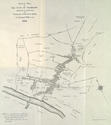 This period saw the feuing (letting) of much of the burgh’s common land. A large portion of the Easter Common was feued in 1595; much of the Wester Common was sold in 1677. The burgh usually reserved the rights in coal and stone. By 1570 the Gallowmuir had been transferred to private owners.
This period saw the feuing (letting) of much of the burgh’s common land. A large portion of the Easter Common was feued in 1595; much of the Wester Common was sold in 1677. The burgh usually reserved the rights in coal and stone. By 1570 the Gallowmuir had been transferred to private owners.
 The Old Green also changed. A ropeworks (1697), a glassworks (enlarged 1742) and the Town’s Hospital (which first opened in 1733 as The Charity Workhouse, and was enlarged 1755) all took away land. Other portions were sold in 1742 and 1752. In 1767 it was decided to sell the Green by lot; the trees were sold to clear the ground for building and it was enclosed (1768). The Old Green had been used for the rouping (auctioning) of the common goods of the burgh, but it had also been a place of recreation, probably including archery in the early 17th century.
The Old Green also changed. A ropeworks (1697), a glassworks (enlarged 1742) and the Town’s Hospital (which first opened in 1733 as The Charity Workhouse, and was enlarged 1755) all took away land. Other portions were sold in 1742 and 1752. In 1767 it was decided to sell the Green by lot; the trees were sold to clear the ground for building and it was enclosed (1768). The Old Green had been used for the rouping (auctioning) of the common goods of the burgh, but it had also been a place of recreation, probably including archery in the early 17th century.
 In the 1660s and 1670s the purchase of land created the New Green (roughly the modern Green). It was enclosed by a stone wall with a guardhouse and locking gates. There was a house for the cowherd and a wash house. It was used for grazing, bleaching and drying nets, and for musters during the 1715 Jacobite Uprising. It was also a place of recreation: there was a race with a prize in 1675; new walks were laid out in 1756; golf was played in the 18th century and by the 1760s there was a bowling green. Even here, however, part of the Laigh Green was given to a woollen manufactory.
In the 1660s and 1670s the purchase of land created the New Green (roughly the modern Green). It was enclosed by a stone wall with a guardhouse and locking gates. There was a house for the cowherd and a wash house. It was used for grazing, bleaching and drying nets, and for musters during the 1715 Jacobite Uprising. It was also a place of recreation: there was a race with a prize in 1675; new walks were laid out in 1756; golf was played in the 18th century and by the 1760s there was a bowling green. Even here, however, part of the Laigh Green was given to a woollen manufactory.